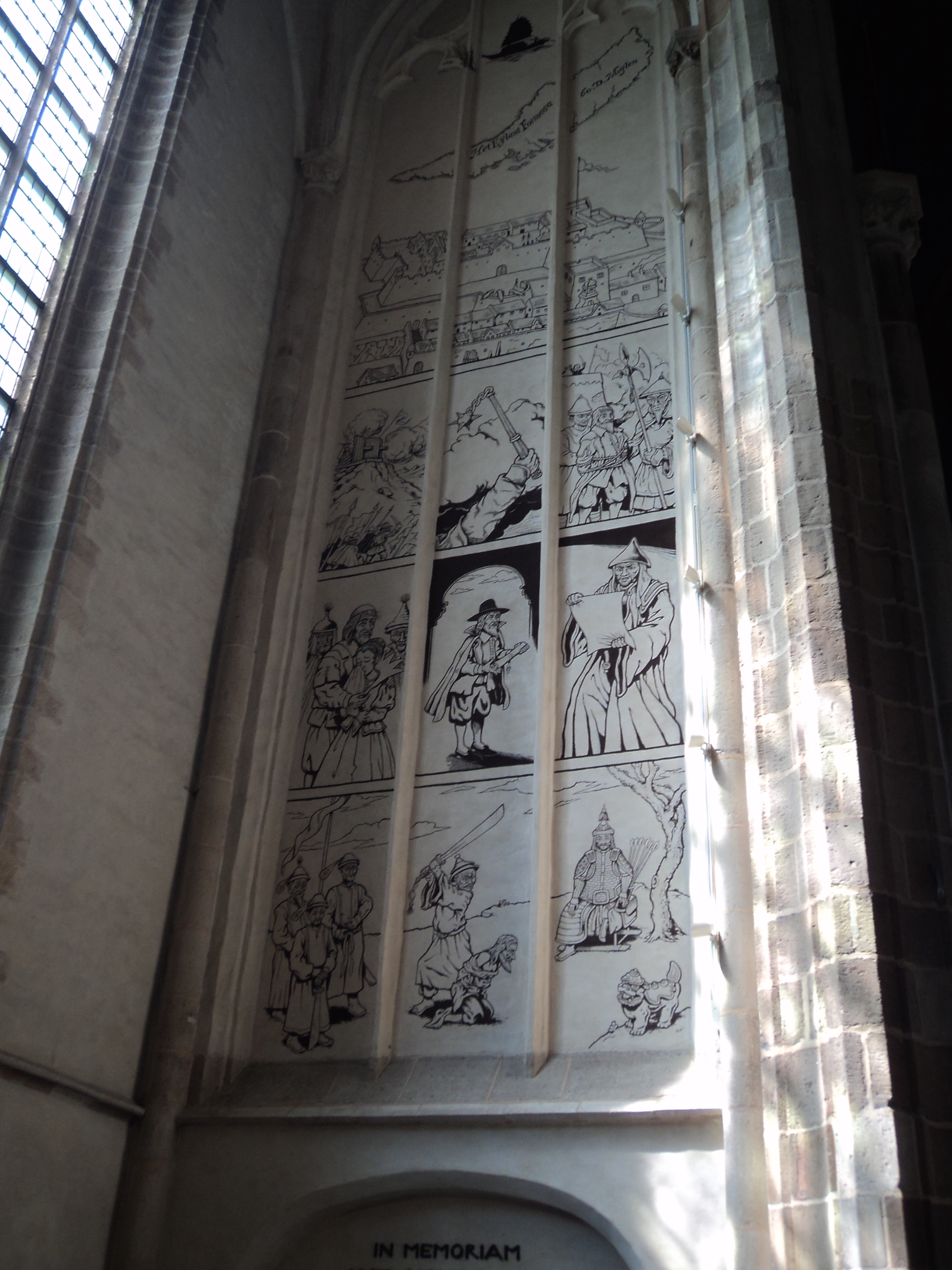Since I’ve worked in public history and education, I’ve spent more time analyzing how cultural sites present information to their visitors. I recently travelled to Belgium and the Netherlands, and their museums and historic sites offered numerous strategies and interpretive choices to consider. With so much history in Europe and so much deliberate attention paid to it, I was interested in how some of these museums and historic sites cope with complicated contingencies in choosing how to package and display the past. In Rotterdam, a modern city in the southern part of the Netherlands, I saw compelling ways of merging past and present.
Grote of Sint-Laurenskerk (Great, or St. Lawrence Church), Rotterdam. (My photo)
A city that was devastated during World War II, Rotterdam is a unique instance of a European metropolis with no qualms about Modernist rebuilding, both architecturally and in terms of the city’s reputation. They had no choice. As a result, the city is full of buildings that are intriguing both inside and out, and public art appears at nearly every plaza or major intersection. Unlike Le Havre, a French city that chose to rebuild their downtown as part of a uniform plan from one architect, Rotterdam embraced the potential diversity of 20th Century architectural styles, and it proves to be a visual feast.
However, while much of the city was rebuilt after World War II, some major structures, like the Grote of Sint-Laurenskerk (Great, or St. Lawrence Church) were heavily damaged, but worth saving. Indeed, the Sint-Laurenskerk is the only remaining part of the medieval city. After it was so heavily damaged by bombing, a debate ensued about restoration versus replacement. They viewed the symbolic value of the church as a reason to restore it—it could provide a reminder of how the Netherlands had survived the war. Today, it is still very much a functioning church, open to visitors and tourists outside of religious events. In my experience, functioning churches are not often masters of interpretation. For a church like the Sint-Laurenskerk, how would it tell its history of restoration in addition to its history as a house of worship?
Like many historic sites in the Netherlands, Sint-Laurenskerk embraced technology in their interpretation. They had a neat interactive computer that allowed visitors to explore images of the church over time. How did the church look in situ from 1700 to 1800 to 1900? How did the artists of the city choose to depict it? Though a fairly simple concept, this interactive is successful. I think tourists, especially those without a background in art and architectural history, often have trouble imagining how such extraordinary buildings could emerge and anchor a neighborhood over centuries.
One chapel—my favorite part!—had fragments of architectural elements from the original church displayed in a large medal grid, allowing visitors to get up close to gargoyles and pieces of columns while also impressing upon visitors the extent of the church’s physical and spiritual damage. The scaffolding seemed to mimic the height of the gothic cathedral, suggesting the extraordinary circumstances that brought these pieces of sculpture closer to the ground. It was remarkable.
Churches built in this cross plan tend to have small chapels lining the exterior walls that, at the time, were meant to honor specific saints or events or, more importantly, to engage donor support. A rich community member might endow a private chapel and further support the church to show his or her religiosity. Today, these niches are natural segments for exhibitions carried over multiple chapels or addressing a theme per niche. And, more importantly, they capitalize on the original function of those spaces—private, individual contemplation—both to show visitors artifacts and to ask them to contemplate their significance as broken remnants of the structure that existed prior to World War II. Beyond the exhibit of fragments, they had a “library” tribute to Desiderius Erasmus, a humanist thinker born in Rotterdam in 1466, and one chapel that used a comic book-style cartoon to tell the story of Antonius Hambroek, a missionary and Rotterdam native, who had been executed in Formosa in 1661. I think that the cartoon was meant to couch the story of Hambroek in the context of Dutch colonialism, rather than simply leaving the memorial below in place and uninterpreted.
These interventions allow the church to function as both a historic site and an integral part of a living community. They didn’t seem particularly expensive (indeed, the church charged a very modest 2 euro admission to tourists), but they created an outsized effect. Churches do not have to be empty of interpretation, relying on the quality of the architecture and enclosed art to draw visitors. They can embrace the community and the less straightforward parts of their history to present compelling and informative displays.






